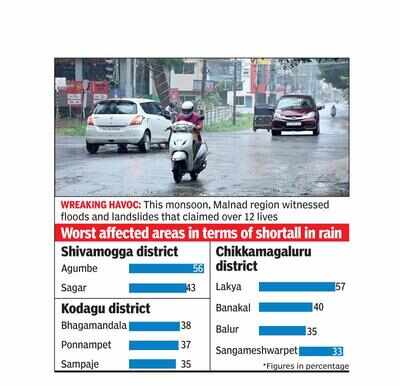
Srinivasa.M
Mysuru: In the first week of August, Kodagu, Chikkamagaluru and Shivamogga districts in the Malnad region witnessed floods and landslides that claimed over 12 lives. All the major reservoirs in the region reached their full capacity, and water was released from dams.
However, according to data compiled by the Karnataka State Natural Disaster Monitoring Centre (KSNDMC), since the beginning of the monsoon on June 1, many hoblis in these districts witnessed a shortfall in rain by over 50%, compared to the normal rain. All the three districts of Malnad received less than normal rain, which worried locals.
Normal rain for Agumbe in Shivamogga,between June 1 and August 22 is 5,874mm. However, till now this hobli received just 2,599mm rain, which is a shortfall of 56%. Bhagamandala, which recorded an all time high of 486 mm rain on August 6, is facing a 38% shortage of rain.
Karnataka State Disaster Management Authority (KSDMA) senior consultant, G Srinivas Reddy, who is also the former director of KSNDMC, said that there has been a decrease in rain in June and July, and more rain in August. “Till the end of July, the rain situation was very alarming due to the dry spells in the Malnad region, however the amount of rain in August improved the situation,” he said.
“The frequency of dry spells and extreme weather events are increasing. There shall be a study of climate change on the local scale, to find out why this is happening,” he said.
According to the data, Shivamogga, Hassan, Chikkamagaluru and Hassan received 13% less rain compared to the normal rain. Chikkamagaluru received 17% less rain, Shivamogga 16% less rain, Kodagu got 14% less rain and Hassan received 1% less rain when compared to the normal rain.
Akhilesh Chippali, an activist from Shivamogga district, said that all the districts in the Malnad region are now witnessing extreme weather events.
“Floods are caused not just by heavy rain, but due to afforestation which is rampant in all the districts in the Malnad region. Even light rain can cause floods and landslides, as there are less trees to reduce the flow of the water. The soil has lost its capacity to absorb rain water. We are facing an ecological disaster,” he warned.
Mysuru: In the first week of August, Kodagu, Chikkamagaluru and Shivamogga districts in the Malnad region witnessed floods and landslides that claimed over 12 lives. All the major reservoirs in the region reached their full capacity, and water was released from dams.
However, according to data compiled by the Karnataka State Natural Disaster Monitoring Centre (KSNDMC), since the beginning of the monsoon on June 1, many hoblis in these districts witnessed a shortfall in rain by over 50%, compared to the normal rain. All the three districts of Malnad received less than normal rain, which worried locals.
Normal rain for Agumbe in Shivamogga,between June 1 and August 22 is 5,874mm. However, till now this hobli received just 2,599mm rain, which is a shortfall of 56%. Bhagamandala, which recorded an all time high of 486 mm rain on August 6, is facing a 38% shortage of rain.
Karnataka State Disaster Management Authority (KSDMA) senior consultant, G Srinivas Reddy, who is also the former director of KSNDMC, said that there has been a decrease in rain in June and July, and more rain in August. “Till the end of July, the rain situation was very alarming due to the dry spells in the Malnad region, however the amount of rain in August improved the situation,” he said.
“The frequency of dry spells and extreme weather events are increasing. There shall be a study of climate change on the local scale, to find out why this is happening,” he said.
According to the data, Shivamogga, Hassan, Chikkamagaluru and Hassan received 13% less rain compared to the normal rain. Chikkamagaluru received 17% less rain, Shivamogga 16% less rain, Kodagu got 14% less rain and Hassan received 1% less rain when compared to the normal rain.
Akhilesh Chippali, an activist from Shivamogga district, said that all the districts in the Malnad region are now witnessing extreme weather events.
“Floods are caused not just by heavy rain, but due to afforestation which is rampant in all the districts in the Malnad region. Even light rain can cause floods and landslides, as there are less trees to reduce the flow of the water. The soil has lost its capacity to absorb rain water. We are facing an ecological disaster,” he warned.
Quick Links
Kerala Coronavirus Helpline NumberHaryana Coronavirus Helpline NumberUP Coronavirus Helpline NumberBareilly NewsBhopal NewsCoronavirus in DelhiCoronavirus in HyderabadCoronavirus in IndiaCoronavirus symptomsCoronavirusRajasthan Coronavirus Helpline NumberAditya ThackerayShiv SenaFire in MumbaiAP Coronavirus Helpline NumberArvind KejriwalJammu Kashmir Coronavirus Helpline NumberSrinagar encounter
Get the app








